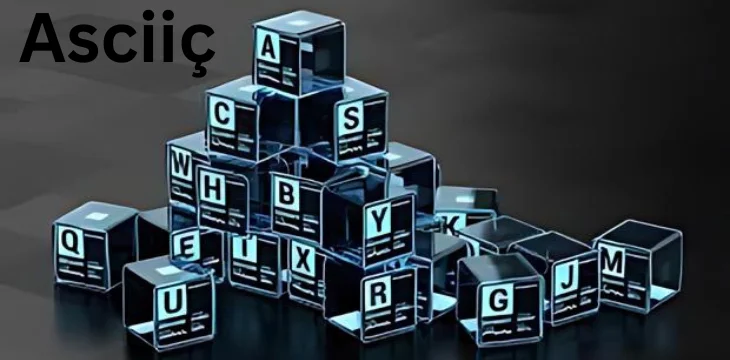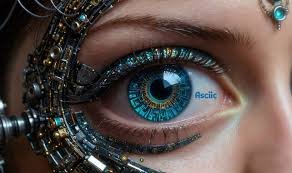Revealing ASCII Art: A Combination of Digital and Creative Expression
Asciiç,Think back to the early days of computing, when enthusiasts and programmers utilized simple characters to create elaborate works of art on their monitors. This is the essence of ASCII art: the fusion of artistic expression with the limitations of digital text. Let’s explore the intriguing realm of ASCII graphics, from its modest origins to its contemporary uses and resources.
Describe ASCII art.

The American Standard Code for Information Interchange, or ASCII, a set of readable characters that can be used to produce graphics and designs in artistic expression. ASCII art, which evolved from the constraints of early computer systems, converts simple text into visual representations, from emoticons to intricate landscapes and portraits.
History and Development of ASCII Art: In the 1960s, as early computing systems became more popular, ASCII art began to take shape. Because there were few or no computer graphics in the 1970s and 1980s, it became more and more popular. In order to produce intricate and inventive artwork, artists and programmers stretched the limitations of ASCII characters. These works frequently shared in online forums and bulletin board systems (BBS).
Methods for Producing ASCII Art
Text letters manipulated to create forms, patterns, and recognizable images while creating ASCII art. Making complex ASCII compositions requires imagination and attention to detail using a variety of methods and resources.
Important Methods:
Character Selection: Selecting ASCII characters according to their structure and visual weight.
Texture and Shading: To enhance depth, apply texture and shade using various characters.
Line Art and Complexity: From straightforward line drawings to intricate pieces with multiple levels of intricacy.
Contemporary Uses of ASCII Art
Even though early computers is where ASCII art originated, digital culture and art communities still find value in it today. ASCII techniques are still being explored and innovated by modern artists and designers, who use them into a variety of platforms and mediums.
- Applications of Today: Digital Art: ASCII art is displayed on social media sites and online galleries.
- Software and Tools: Editors and generators of ASCII art make creation easier for hobbyists.
- Interactive Installations: Digital ASCII displays are a part of public art shows and installations.
ASCII Art in Media and Pop Culture
Pop culture has been profoundly impacted by ASCII art, which may be found in movies, video games, and even mainstream advertising. Its distinct style and sentimental appeal appeal to viewers of all ages continue to inspire new directions in digital expression.
Pop Culture Allusions:
- Early video game interfaces and graphics created using ASCII art.
- Internet culture: ASCII pictures and memes that become viral on forums and social media.
- Advertising: Ingenious campaigns that use ASCII design to build engagement and brand.
Illustrations and Exhibition of ASCII Art
Let’s examine some prominent instances and present works of ASCII art that demonstrate the adaptability and inventiveness of this distinctive genre. With its unique visual language, ASCII art never fails to enthrall and inspire, whether it is creating intricate landscapes or minimalist designs.
| Example | Description |
|---|---|
| ASCII Portraits | Detailed human portraits using text symbols |
| ASCII Landscapes | Scenic views and nature scenes in ASCII |
| ASCII Animations | Moving images and GIFs created with characters |
| ASCII Typography | Creative use of letters and symbols for artistic typography |
Software and Tools for Making ASCII Art
Specialized tools and software that improve the design and creation process make it easier to create ASCII art. These resources span the spectrum from basic web generators to sophisticated editors designed for both pros and amateurs who enjoy ASCII art.
- Suggested Resources: ASCII Art Generator: Digital resources such as Text-Image.com and ASCII Art Studio.
- Web-based Generators: Websites that provide ASCII text and picture conversion that can customized.
- Mobile Apps: Applications that let users directly create ASCII art on tablets and smartphones.

Understanding Asciiç: A Full Guide in 2024
In the digital encoding world, 2024 is shaped by new standards and emerging technologies that keep coming into the limelight to suit current demands of computing and digital communication. Nonetheless, some of the older encoding systems continue to find value, such as the American Standard Code for Information Interchange commonly referred to as ASCII. A building block of text encoding, ASCII takes part in most applications which represent text in computers, telecommunications equipment, as well as in devices.
One of the recent topics of curiosity is “Asciiç,. It would seem like a variation or specific usage of ASCII that employs special characters, especially the “ç” character that is employed in many Latin-based languages. This blog post delves into the relationship between ASCII and special characters such as “ç” and gives updated information about the broader picture in which encoding systems fit in 2024.
What is ASCII?
Before we get into “Asciiç,” it would help to know what ASCII is. ASCII is the abbreviated form of American Standard Code for Information Interchange. ASCII is a character encoding standard for electronic communication, designed in the early 1960s. It encodes 128 specified characters with seven-bit binary integers. The characters it encompasses include:
Upper and lower case letters, that is A-Z, and a-z

- Digits or numbers from 0-9
- Basic punctuation marks, like period, comma, question mark, etc.
- Control characters, like carriage return, line feed, etc.
- For decades, ASCII was the standard character encoding for text in computers, but ASCII has the disadvantage that it only supports 128 characters-it is difficult to use accented characters or symbols from languages other than English-or special characters like “ç”.
Asciiç in 2024
Today, ASCII and extended ASCII, which contain special characters like “ç,” still apply in legacy systems, simple text files, and certain programming environments. Newer applications, however, have more comprehensive systems of encoding-like Unicode-that have become the global standard.
Unicode is a universal character encoding system to encode almost all characters from all languages and scripts, comprising more than 140,000 characters. It goes beyond the Latin script, including Chinese, Arabic, Cyrillic and others. Each of the characters, “ç”, for example, has a special code point in Unicode-U+00E7.
Although Unicode has become a standard for writing systems, extended ASCII and by extension, Asciiç is still found useful for certain legacy applications, simpler text processing, and environments that prefer minimal memory usage.
Asciiç in Contemporary Systems
In the majority of contemporary character encoding schemes, programmers and users are free to dispense with ASCII or extended ASCII when working with characters like “ç.” Yet there are some special circumstances where using these older schemes is unavoidable: preserving legacy software functionality for backward compatibility, or processing simple text files that place minimal demands on encoding.
Let us now represent and make use of the character “ç” in various contexts using the following examples:
In HTML/Unicode
In modern web development and text encoding, the agreed-upon way of spelling special characters is through Unicode. For “ç”, you can use the Unicode character reference:
In Extended ASCII
If you are using a legacy system that supports extended ASCII, then you may represent “ç” with its extended ASCII code:
In Legacy Systems
Even some old databases, text processing systems, or communication protocols still may use ASCII and extended ASCII. In such systems “ç” would be referenced by its extended ASCII value or would appear encoded within files not optimized for modern character representation.
Why ASCII Still Matters in 2024

Although Unicode has, in effect replaced ASCII and extended ASCII in most computing environments, there are more important reasons to know and use ASCII, and especially the extended version.
Legacy Systems
Many older software applications, file formats, and communication protocols use ASCII encoding. Knowing how characters such as “ç” are encoded in these environments ensures compatibility and correct text display when operating in a legacy environment.
Low-Memory Environments
When memory is very scarce, as it is in embedded systems or microcontrollers, using ASCII may be the preferable choice because of their very minimal memory footprint compared to Unicode. In those situations, extended ASCII that includes Asciiç offers a way to accommodate more characters without Unicode overhead.
Simple Text Files
ASCII is still very feasible for such applications requiring simple text representation without Unicode’s complexity. For text files, configuration files, or other legacy systems not requiring Unicode full range of characters, ASCII and extended ASCII are still there to be used.
ASCII Art FAQs
What is the meaning of ASCII art?
With the use of text characters, ASCII art, or American Standard Code for Information Interchange art, produces visual images.
How do you make art in ASCII?
Text letters arranged to make identifiable images or designs in ASCII art. Character selection, spacing, and shading done using a variety of ways.
Where can I get examples of ASCII art?
A vast array of samples, from straightforward drawings to complex artworks, displayed in online galleries, art communities, and ASCII art forums.
Can I make a profit from ASCII art?
Many ASCII artists share their work under open licenses, though usage permissions vary. If you use ASCII art for business purposes, make sure to always check the licenses and provide acknowledgment.
Which ASCII art symbols are now in vogue?
Popular symbols that are frequently used in emoticons and ornamental designs include smiley faces, hearts, stars, and geometric forms.
Is ASCII art significant in the modern era?
Absolutely, ASCII art still valued for its creative originality and nostalgic appeal in modern digital society.
Conclusion
Even in the digital age, ASCII art is a monument to human inventiveness and innovation. From its beginnings in the early days of computing to its broad use in contemporary society, ASCII art connects the dots between creativity and technology. ASCII art provides a distinctive platform for digital expression, whether you’re interested in learning about its history, perfecting its techniques, or just enjoying its visual impact.

